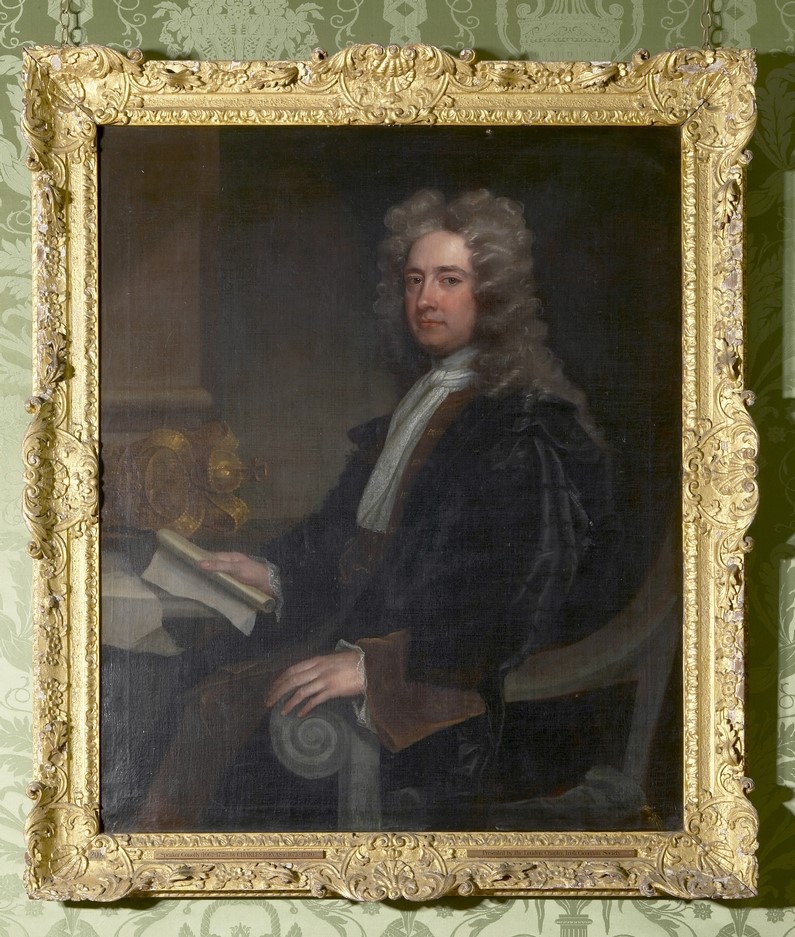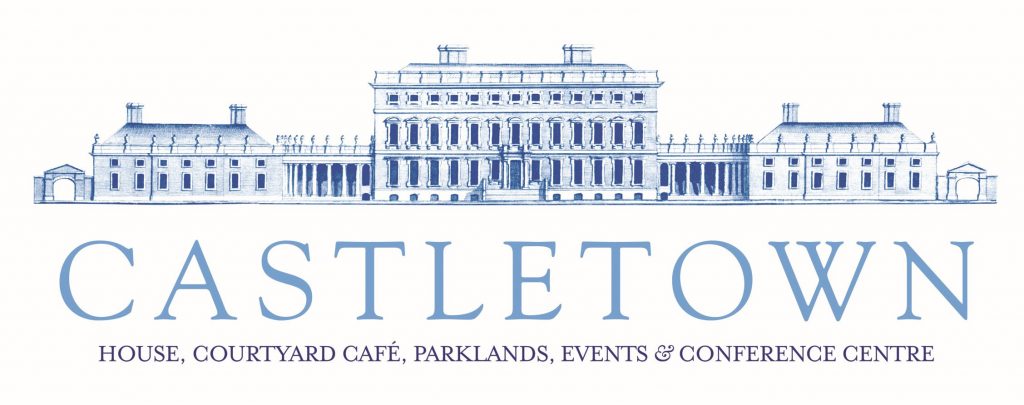Speaker William Conolly and Castletown House
Thank you to Castletown House head guide Sandra Murphy and Castletown House guide Celine Hanratty for the historical information and photographs.
Castletown House & Parklands, Celbridge, Co Kildare have also identified the relevance of this discussion in the ongoing evolution of Irish society and are providing a unique location and excellent conference facilitates. When it was built in the 1720s, Castletown House set a radical precedent and today is a key part of Ireland’s cultural inheritance. As the OPW breathes contemporary life into Ireland’s earliest and finest Palladian house, it also provides a safe and secure environment for an open discussion on what it means to be Irish in the 21st Century.
Speaker William Conooly

Speaker William Conolly himself offers a starting point for this discussion. His father's family were originally Catholics from Co. Monaghan. At some point thereafter the family converted to the Anglican faith. At a time of upheaval during the Penal Laws his father Patrick was forced to move to Donegal where he became an innkeeper. William was born in Ballyshannon in 1662. Patrick generated sufficient wealth to educate his children. This enabled William to qualify as an attorney and to begin practicing law in Dublin in 1685.
His political influence was consolidated through his marriage to Katherine Conyngham in 1694. Katherine was the daughter of famed Williamite hero Sir General Albert Conyngham; an Ulster Scot who had settled at Slane Castle, Co Meath. This marriage brought not only a substantial dowry but also political connections to many of Irelands most powerful and influential families. She brought important connections, her sister was married to the Irish accountant general James Bonnell and her brother Henry Conyngham had excellent political connections including the banker William Cairns and rising political stars Alan and Thomas Broderick. She also brought £2,300 of a dowry, a direct manner, strong personality and valuable political skills. They were a powerful couple socially, politically, and financially.
Following confiscation by the Crown of lands belonging to supporters of King James II in the wake of the Williamite War, almost 600,000 acres were confiscated and sold to pay for the costs of the war. William Conolly was the largest individual buyer purchasing 3,300 acres in Co. Meath. The Castletown estate of 1,890 acres was purchased in 1709 from Colonel Thomas Dongan for £15,000 and commenced work on Ireland’s first winged Palladian house in 1722; specifying that every part of it had to be made from Irish materials. It was an odd decision to build as the Conolly’s were in their sixties at that point and had no children. But Castletown was not built to be a family home, its purpose was to entertain and impress. Castletown was more impressive than the vice regal residences at Dublin Castle or Chapelizod. The house was to be their legacy, a physical manifestation of their social, political and financial power.
In 1725 he added 439 acres at Killadoon and in 1728 he purchased Leixlip Manor, which included the town but not the castle. Conolly had established himself in Kildare. He began to entertain and conduct government business in the existing house at Castletown, described in the deed of purchase as: ‘a very good dwelling house, with gardens of pleasure, a good kitchen garden and good orchard, a fine wood and hopyard. He also commissioned construction of the former Customs House in Dublin (now the Clarence Hotel) and the Irish Houses of Parliament (the world's first specifically designed bicameral parliament).
William was also a Member of Parliament for Donegal Borough from 1692 to 1703 and subsequently for Londonderry County until 1729. In 1703 and 1713 he was also elected for Newtown Limavady and in 1727 for Ballyshannon. However, his most famous role was that of Speaker of the Irish House of Commons. He was also a Commissioner of the Revenue from 1715 until his death in 1729.
Alongside his political success he also amassed the largest personal fortune in Ireland, with an estimated 150,000 acres creating a rent roll of £17,000 annually. He was the single biggest purchaser of forfeited estates after the Williamite Wars, when James II was defeated. From 1703 onwards he concentrated on the northwest of Ireland for political reasons and the area around Dublin for personal and political prestige.
His family heritage was not lost on the gentry he found himself working and living with. In 1717, when William Conolly was appointed as a Lord Justice, Sir John St Leger remarked snidely that: ‘many people here especially our quality and old gentry are much offended at Mr Conolly’s being one of them; this gentleman was lately an attorney, his father keeping an ale house in the North of Ireland, this being too notorious to be stifled’.
The son of the innkeeper had the last laugh. By the time of William’s death he was the most powerful politician and the wealthiest man in Ireland. The Latin inscription on his funerary monument in the church at Tea Lane, Celbridge, gives a short synopsis of his political career. When translated it says that he was Commissioner of the Revenue in the reign of Queen Anne and George I, Privy Councillor in the reign of George II, twice elected Speaker of the House of Commons in Ireland and ten times held the Office of Lord Justice of Ireland.
In his will, written 12 days before his death in 1729, William Conolly made the decision to be buried in Celbridge. He didn’t chose his hometown and political stronghold in Donegal. He didn’t choose Dublin where he had a large residence on Capel Street and where his political career had thrived. He choose Celbridge, forever entwining the Conolly name and Castletown.
After his death on 30th October 1729 Katherine organised: ‘the finest funeral that has been seen in this kingdom in many years’. The reception room and staircase of the house in Capel Street were draped with black fabric. Sixty seven poor men dressed in black walked in front of the coffin, one for each year of his life. 700 mourners walked with the coffin from Capel Street to Arran Quay on foot, many then travelling to Celbridge. The funeral was larger and more elaborate than that of Archbishop King who died the same year. Katherine was determined that William Conolly would be respected in death.
William left money in his will for a chartered school for forty orphans or poor children and Katherine built it as requested. Today it is the Celbridge Manor hotel. In 1736 an elaborate heraldic funerary monument was completed in Tea Lane church with life size marble statues of Katherine and William. It was so large that the church had to be extended to accommodate it. In the 1740s Katherine completed the obelisk known as Conolly’s folly and the building now known as the Wonderful barn. Castletown House, the funerary monument, the charter school, the folly and the barn are today physical reminders of William Conolly, the self-made man who built an enduring legacy, the Conolly’s of Castletown.
The Conolly dynasty and the future of Castltown House
William and Katherine had no children of their own and after Katherine’s death in 1752, the estate was inherited by his nephew, also named William Conolly. William and his wife Anne took up residence at Castletown but their tenure was short lived as William died two short years later leaving the house to his son Thomas Conolly.
Tom Conolly and his wife, Lady Louisa took possession of the house in 1759 and embarked on a period of improvements to the house and estate. Lady Louisa was born Louisa Augusta Lennox in 1746 at Goodwood, the daughter of the second Duke of Richmond and descended from King Charles II of England. She was accustomed to the latest in fashion and through her French ancestry, an appreciation of European taste and design. Her improvements to the house are estimated to have cost £25,000. She began with the creation of a Dining Room from two rooms of a bedroom apartment on the ground floor, the Dining Room only coming into fashion in the mid eighteenth century. She also changed two drawing rooms on the ground floor, using design inspiration from the published works of William Chambers and Isaac Ware. The creation of a Print Room, the only intact eighteenth century print room is Ireland, took up to ten years and can be seen as a representation of popular taste and culture in mid eighteenth century Ireland. The Long Gallery was redecorated in the Pompeiian style and changed in use from a formal picture gallery to a newly fashionable living room. The Venetian chandeliers adorned with colourful glass floral decorations are the only set of coloured Venetian chandelier in Ireland. However, Louisa’s greatest improvements to the Castletown Estate can be said to be her parkland. She created a Brownian style landscape with a picturesque river walk of her own design, a gothic walk and a new Pleasure Garden and farmyard on the site of the original castle.
The estate continued in Conolly ownership until 1965 when the Conolly Carew family sold the estate. The house was subsequently bought by the Hon. Desmond Guinness and his wife Mariga in 1967 and opened to the public, it being the first house to be opened to the public in Leinster. Desmond Guinness and the Castletown Foundation managed the house until 1994 whereupon it was acquired by the state. The Office of Public Works then embarked on a programme of restoration which began with structural repairs including the re-roofing of the house and repairs to the façade stonework. Restoration has continued ever since both in the house and in the restoration of the landscape, gate lodges, the Pleasure Gardens and ongoing works to restore the farmyard buildings.
For more on Castletown House & Parklands you can visit their website by clicking here
